RAPA NUI SKIN: EASTER ISLAND INK
©
2005 by Lars Krutak
|
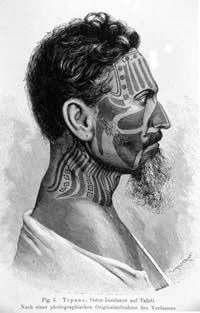
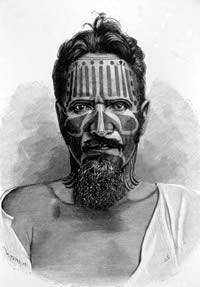
Portrait and profile views of Juan Tepano, 1880s. Engravings after the drawing of Hjalmar Stolpe, a Swedish ethnographer. |
On Easter Sunday, 1722,
the Dutch navigator Jacob Roggeveen was cruising the vastness of the
South Pacific when he sighted a small volcanic island in the distance.
Landing at a rocky cove, his crew marvelled at colossal seven-meter high
stone statues (moai) standing in silent rows along the shore. And
perhaps at that moment his men began to wonder just who lived in this
mysterious place cut off from the world. It seemed that Easter Island
had developed in complete isolation for centuries.
The Easter Islanders, who today refer to themselves and to their homeland as Rapa Nui, are the easternmost of some 36 Polynesian peoples whose ancestors discovered and settled the islands of the central and eastern Pacific. They share a common ancestry with other Polynesians, such as the Hawaiians, Tahitians and the New Zealand Maori.
The ancestors of the Polynesians began to migrate from Southeast Asia about 1500 B.C., and sometime between A.D. 600-800 they arrived on Easter Island. According to Rapa Nui legend, the island was settled by Hotu Matu'a, a powerful chief who arrived with a party of colonists in two large sailing vessels. At this time, dense palm forests and stands of small trees covered the island, and the coasts were visited by seabirds, sea turtles, and marine mammals. Over time, however, the trees were cut and by the close of the 19th century, Rapa Nui was virtually a barren landscape.
Rapa Nui Tattoos
All Rapa Nui art blends anthropomorphic and zoomorphic imagery into superbly crafted and almost surrealistic forms. No wonder that this art inspired a number of Surrealist painters, particularly Max Ernst, whose works often contain imagery inspired by Easter Island art. As noted, wood for carving was rare, but barkcloth (tapa), from mulberry trees, was rarer still and, perhaps, even more important. Where Hawaiian chiefs wore red feather cloaks to cover their backs and assert their high, god-like status, the Rapa Nui chiefs wore tapa.
The rarity of barkcloth suggests that tapa figures - possibly receptacles for ancestral spirits - might have been considered high-status substitutes for wood figures. Unfortunately, only five of these barkcloth figures (manu uru) are known to exist in museum collections, but all are decorated with paintings representing tattoos.
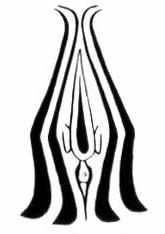
Stylistic frigate bird tattoo. This
motif appeared
on tapa figures
and human skin, specifically on
Juan Tepano's throat, 1880's.
Illustration by Hjalmar Stolpe.
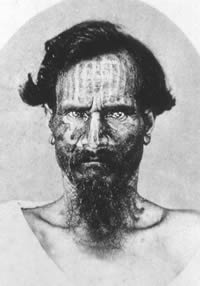
Carte-de-visite of Juan Tepano,
a Rapa Nui nobleman, 1870s. |
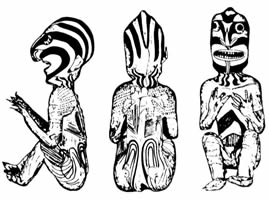
Sketch of a fully-tattooed tapa barkcloth figure. The swooping, plunging frigate bird tattooed on back above buttock (center view) is symbolic of war and headhunting.
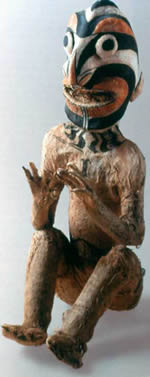
Tapa barkcloth figure (manu usu). Reeds,
barkcloth and paint, 19th century. Forty cm.
Note neck, facial and torso tattoos. |
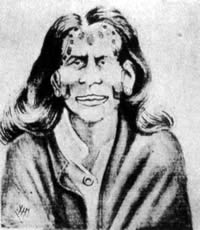
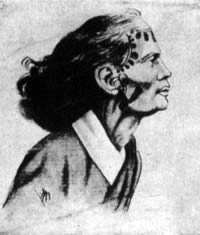
Portrait and profile views of Ana Eva Hei,
the wife of one of the last "kings" of
Easter Island, 1911.
Tattooing was virtually extinct by 1920.
Illustrations by Walter Knoche. |
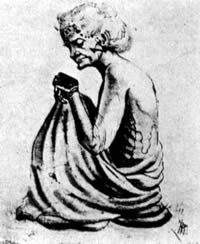
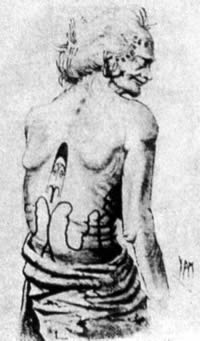
Profile and back view of Old Viriamo, Juan Tepano's mother, 1911. Illustrations by Walter Knoche. |
Throughout Polynesia, tattoo was widespread and often associated with chiefly or warrior status. The face, neck, torso, back, legs, arms and top of the head were tattooed, and Rapa Nui tattooing implements (ta kona) were similar to those found elsewhere in Polynesia (a comb of bird bone lashed at a right angle to a wood handle). The comb was dipped in a prepared pigment of charred ti leaves (Cordyline terminalis) mixed with black nightshade (Solanum nigrum) juice and struck with a mallet into the skin. In Hawaii, ti was considered sacred to the god Lono and to the goddess Laka. Ti leaves were emblems of high rank and divine power, and were carried to ward off evil spirits and bring good fortune.
Sadly, only one photograph survives of traditional Rapa Nui tattooing. This 1870s carte-de-visite, made by Tahitian photographer Madame Hoare, portrays Juan Tepano, a Rapa Nui nobleman, with neck and facial tattoos. The Swedish ethnographer Hjalmar Stolpe who traveled the Pacific in the 1880s also illustrated him in portrait and profile views.
By 1911, only four islanders out of 228 wore traditional tattoos, and these were women. By 1930, only two survived: Juan Tepano's mother, old Viriamo, and Ana Eva Hei, the wife of Atamu Te Kena, one of the last "kings" of Easter Island. Neither woman was completely tattooed and Viriamo said she refused to submit to further sittings because the tattooing operation was too painful. Ana Eva Hei, who was younger, was tattooed by one of the last experts.
Generally speaking,
Rapa Nui tattoo was comprised of fundamental motifs preserved and passed
from one generation to the next. It is true, however, that personal
taste varied and perhaps different clans had favorite designs. But
certain designs were more common than others. Women and men very often
had heavy lines on their faces, which, crossing the forehead, extended
from one ear to the other. These lines were curved and combined with a
series of large dots (humu or puraki, "to enclose") that marked the
forehead and temples. They are also seen on existing barkcloth figures,
but in smaller detail. On the cheeks of women below the ears was a motif
called pagaha'a ("something that hangs heavy"), formed by the meeting of
two designs, one triangular and the other fusiform (tapering at each
end). An old spelling of this word is pangehua and based on the root hua,
it can be suggested that these were fertility markings. Hua means
"testicle," or more figuratively, "son." Tattooed rings (ngutu tika)
surrounded the mouths of women, possibly akin to the Maori custom, while
three vertical lines descending the mouth sometimes crossed the chin.
These motifs appear on some of the barkcloth figures.
|
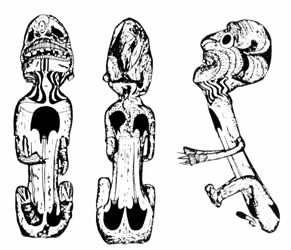
Tapa barkcloth figure (manu usu). 'Ao paddle tattoo prominently marks the torso and back. These tattoos were seen on one old woman living on the island as late as 1930. Tapa figures may have functioned as receptacles for ancestral spirits.
|
On the back of old Viriamo, between the shoulder blades, is a motif called 'ao ("dance paddle") with conventionalized eyes and nose. Along the lower part of the back, and under the 'ao is a stripe which winds back and forth. These bands or "dancing torsos" are tattooed in one continuous design around the body. On one barkcloth figure, the same tattoo design covers the buttocks and the waist region, and the band terminates at a bird design with a beak joined by two concentric rings. It is possible that 'ao motifs have an ancestral significance, especially since the word 'ao also refers to the ruling elite, suggesting that only aristocrats could wear these tattoo motifs.
Juan Tepano's forehead tattoos (retu, "to stand") consisted of six to ten solid vertical stripes. The parallel lines across the forehead and the fringe of dots were the first motifs tattooed on the face. This pattern was the most general, since it was the one commonly recorded by early voyagers. But of considerable interest are the tattoos that you cannot see. Beneath Tepano's chin and beard (on the throat) is a stylized bird with head turned down, elongated body and wings reduced to four small tattoo lines. This motif, also seen in other abstract versions on barkcloth figures, is that of the frigate bird. The frigate, a predatory bird that flies swiftly and cunningly, is widely associated with the tattoo traditions of several indigenous peoples of Polynesia, Melanesia and Indonesia, and is symbolic of headhunting and warfare. Also, on the right side of Tepano's spine is a set of nine parallel lines, running vertically and bending to the right at the bottom, reminiscent of a bird swooping downwards with wings outstretched. These same tattoos appear on a barkcloth figure. Other tapa figures have more abstract images of birds on their necks and hips.
To me, this bird symbolism is apparent in the fundamental decoration of the neck (ua), which was essentially masculine, consisting of four pairs of broad and wavy stripes. Also appearing on large stone moai around the island, these tattoos look like bird feathers and combine with other tattoos to transform the wearer into a "birdman." As early as the 15th century, a series of annual religious ceremonies developed on Rapa Nui that centered on the creator god Makemake, whose earthly manifestation was the tangata manu or birdman. Born from a floating skull that was washed from a temple into the sea, Makemake created the first humans and with his companion, the goddess Haua, brought the first flocks of migratory seabirds to the island.
Sacred Skin
From the monumental moai statues that guard the shores, to the richly textured tapa figures and the tattoos that marked the skin of humankind, the creation of religious art for the gods and ancestors of Rapa Nui made visual personal conceptions of human existence in one of the most remote places on Earth. Rapa Nui tattoos made the skin sacred, increasing the spiritual power (mana) of the adorned by enabling the individual to communicate more closely with his gods; gods whose powers could sustain or destroy the world.
Works cited
Knoche, Walter
1912 "Tres notas sobre la isla de Pascua: I. Observaciones de algunas
pinturas, en sus
reproducciones. II. Los últimos tatuajes en la isla de Pascua. III. Un
cuento y dos canciones. Imprenta universitaria. Santiago de Chile,
Métraux, Alfred
1940 Ethnology of Easter Island. Bernice Bishop Museum Bulletin 160.
Honolulu.
Stolpe, Hjalmar
1899 "Über die Tätowirung der Oster-Insulaner." Abhandlungen und
Berichte des
Königlischen, Zoologischen und Antropologisch-Ethnographischen Museums
zu Dresden 8, no. 6.
|











